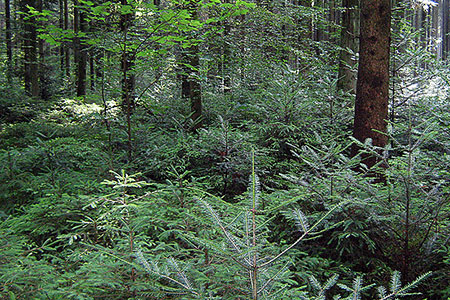The advantages of natural regeneration are obvious: Natural regeneration is usually adapted to the site, plant density is often higher (equivalent to a risk buffer against the effects of damage) and naturally regenerated plants are less at risk of browsing damage than tree nursery plants. Forest owners nevertheless still prefer artificial regeneration in many places. Forest managers should however not only consider the silvicultural aspects of natural regeneration, but also the economic aspects, to make themselves fully aware of the influence of the planting costs.

Fig. 1: Lush natural regeneration of fir and beech in the Schönwald forest near Fürstenfeldbruck; anyone opting for natural regeneration rather than planting gains not only ecologically, but can also save a lot of money (Picture: G. Brehm).
Calculation - on an individual basis and clearly understandable
In comparing forestry yields, it is essential to take the temporal aspects into account. Artificial stand establishment weighs particularly heavily here, as it ties up the capital for a long time - over the remainder of the rotation period.
Forest economics should focus on the anticipated cash flows within the life of a stand. These cannot be compared unless the time value of the money is taken into consideration. This time value of the money is calculated on the basis of capital budgeting, as applied e.g. in forest machine cost calculation. It is important to understand the influence of the interest effect on forest management decisions. Here we demonstrate how an individual calculation can quickly be made and presented clearly using simple tools.
Time value of money
Between the point in time at which the stand is established and the harvesting of the timber, there may be several changes in generation. Uniform payments - whether expenditure or revenue - cannot thus have the same weight if they are due at different points in time. The prospect of future amounts of money is subject to uncertainty. Money can lose value (inflation), timber prices may fall, or the stand may fall victim to storms or to bark beetles. In addition, money that comes in later can also only be re-invested later. Future revenues thus bear less weight than those that come in immediately, while future expenditure is less of a burden than current expenditure.

Fig. 2: There are often several changes of generation between establishment of the stand and harvesting; yields thus arise at different points in time (Picture: G. Brehm).
A thorough calculation: present value, capital value and annuity
The thought behind the interest calculation is that the forest owner does not have to invest in a plantation. He could invest the money in a different way, by buying additional forest, for example. Interest gains are thus possible. The forest owner loses these if he chooses to establish the plantation. From the economic point of view, these interest gains must be taken into account as opportunity costs. All payments are thus discounted using a calculation interest for the period in consideration.
In forestry in Germany, we can operate with interest costs of around two to three per cent. Only if the time aspect and the associated opportunity costs are taken into account is it possible to make all payments at different times comparable. The discounting of a payment gives the present value, shown here for revenues of €100.00:
Payment
Present value = -----------------------------
(1+interest rate) Year of payment
Alternatively, the capital value can be transformed into equivalent annual annuities. This allows the forest owner to see what annuity per hectare from the respective stand corresponds to the previously calculated capital value:
Interest rate (1+interest rate) Rotation period
Annuity = Capital value x ---------------------------------------
(1+interest rate) rotation period - 1
Natural regeneration vs. planting
In order to compare a naturally regenerated stand with a planted stand in financial terms, it is necessary to estimate all anticipated cash flows or net revenues until the planned end of the rotation period. The establishment costs and tending costs for the two stands will usually be different. The volume growth or length of the rotation periods may also be different. An imputed wage for the forest owner working in his own forest must be allowed for - he could of course have used his working time in a different way.
If two stands differ only in terms of their establishment costs, it is possible to use the annuity to calculate the amount by which the annual average profit margin of a stand is lowered by the establishment costs. If expenditure for the planting amounts to €3000.00/ha, the average rotation period is110 years, and the interest rate is 2%, the following annuity can for example be calculated:
The initial investment costs are distributed here over all years of the rotation period, taking account of the interest effect. The possible annuity is thus reduced by €68.00
The Department for the Forest Inventory and Sustainable Use at the Technical University of Munich offers a simplified Excel-tool on its website for the calculation of present value, capital value and annuity. There is also a comparison of two stands given as an example. The tool allows forest owners and advisers to compare management alternatives using their own empirical numbers.



